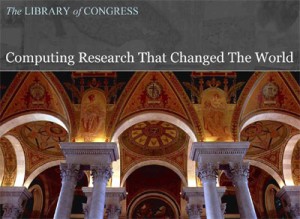 Susan Graham provided a great overview in a post a few days ago of the Computing Community Consortium’s March 25th day-long Library of Congress symposium, “Computing Research that Changed the World: Reflections and Perspectives.” I thought I’d provide a few additional details — as well as a reminder that all materials (slides, videos, a summary booklet, etc.) will be available on the CCC website in the very near future.
Susan Graham provided a great overview in a post a few days ago of the Computing Community Consortium’s March 25th day-long Library of Congress symposium, “Computing Research that Changed the World: Reflections and Perspectives.” I thought I’d provide a few additional details — as well as a reminder that all materials (slides, videos, a summary booklet, etc.) will be available on the CCC website in the very near future.
Inspiration for the program came from a large number of responses from the computing research community to two November CCC blog posts — this was your symposium!
Each of the talks was superb. Honestly, in 35 years in the field, I’ve never before spent a day with such uniformly high quality of content and presentation. It was remarkable. The videos of the 20-minute talks will be a great resource for all of us.
My introductory talk (pdf) provided a quick overview of the impact and promise of the field, as well as a peek at the day’s program. I drew upon a recent New York Times article describing a Wharton School assessment of “the top innovations of the last 30 years” (more than half of which were direct results of computing research!) as well as a recent CSTB study “Assessing the Impacts of Changes in the IT R&D Ecosystem” (which described a day without information technology as “a day the Earth stood still”).
My closing remarks summarized both the content and the messages of the day-long symposium. I won’t repeat Susan’s earlier summary of the content, but here are a few additional highlights:
- Alfred Spector commented that “Google did not arise through spontaneous generation in a garage in Palo Alto — it drew upon a broad set of computing research advances.”
- A number of the talks — Luis von Ahn‘s, Jon Kleinberg‘s, Rodney Brooks‘s, probably others — alluded to emerging “hybrid systems”: humans + computers.
- Daphne Koller presented a terrific catalog of the successes of machine learning.
- Gene Myers asserted that “computation is the bottleneck in every [modern molecular biology] project” — a perfect bookend to Larry Smarr‘s session-leadoff talk on the transition to data-intensive science.
- Chris Johnson made it clear that in the past decade, modeling and visualization have become valuable tools in advanced surgical practice — M.D.’s are beating down his door to obtain access.
- Pat Hanrahan presented neat timelines of the transformation of all media — publishing, audio, photography, and video — from analog to digital.
- Rodney Brooks ended the technical sessions on a cautionary note: The future of robotics is robots that operate in unstructured environments. America has a wide lead now in this field. But once, we led in manufacturing robotics, and we allowed that lead to slip away. Will we allow that to happen again?
That’s a good jumping-off point for the messages of the day. Here’s my list:
- Computing research truly has changed the world.
- A rich and complex ecology — involving government, academia, and industry — has made America the world leader.
- Research has laid the foundation — you can find federally-funded university-based research at the heart of essentially every billion-dollar sector of the IT industry.
- It consistently takes 10 or 15 years from “research breakthrough” to”billion-dollar sector.” So you need patience — there’s no such thing as “just-in-time research.”
- Often, “products” in IT are created by synthesizing multiple advances — unlike biomedicine, where a single patent can yield a blockbuster drug.
- Often, old ideas gain new life. We’ve had recent breakthroughs in search and in machine learning, but each traces its roots back at least 40 years.
- While computing research often is motivated by a “strategic objective” — we see a practical value if the research succeeds — we’re often not very good at predicting what the greatest impact of our innovations will be. Serendipity plays a huge role. Any attempt to decide early-on what research is “important” is likely a losing proposition.
- While much of the exciting computing research today is interdisciplinary and collaborative, it’s important to have a balanced portfolio: core + interdisciplinary, single-investigator + team, etc.
The bottom line: We have an extraordinary track record — America has an IT R&D ecosystem that again and again leads to massive transformations. And the next ten years can be our golden age: on March 25th we heard about some amazing recent accomplishments, and we heard from some extraordinary young people (as well as some extraordinary not-so-young people) who are driving the field forward. The opportunities for impact are greater than they have ever been. Go out and change the world!










Trackbacks /
Pingbacks